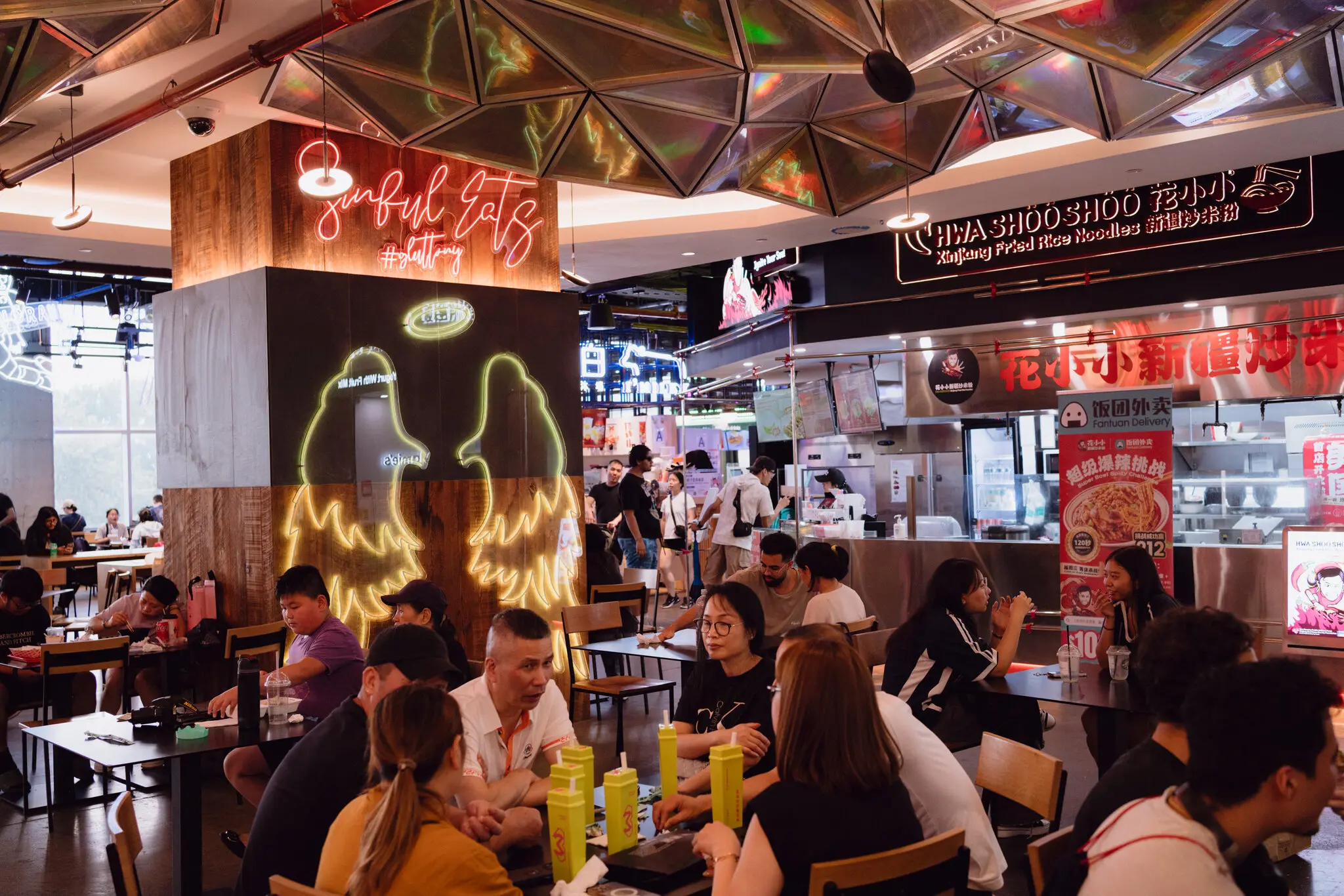
With Labubus and a Cat Cafe, a Shopping Mall Thrives in New York City
The city’s newest indoor shopping center, in Queens, has defied predictions of the death of the American mall by catering to Asian American shoppers.
On a warm Tuesday afternoon in Queens, ’90s hits were blaring and the mall was bouncing.
On the upper level, a family ate a late lunch around a cauldron of soup. Near the atrium, a girl chased neon tiles flashing on an interactive floor. In the cat cafe, a woman sought a relaxing moment with Dina, a gray-and-tan rescue dozing against a window.
Welcome to Tangram: a 275,000-square-foot indoor shopping center in the middle of Flushing that is defying the slow death march of the American mall.
Across the country, about 10 malls close every year. Only 950 remain open nationwide today, down from a peak of several thousand at the end of the 20th century, according to Green Street, a real estate research firm. Many are now empty relics of American consumerism, conjuring memories of anchor department stores and after-school hangouts.
Those that are hanging on, like the Kings Plaza Shopping Center in Brooklyn, are increasingly hollowed out. On a recent visit to Kings Plaza, there were few shoppers, 11 vacant storefronts and a boarded-up space where a McDonald’s used to be.

Image

Home to some of the world’s most prestigious retail corridors, New York City has not been known as a mall city. (The massive Manhattan Mall shut during the pandemic.) Things are different in the suburbs, where malls like Roosevelt Field on Long Island and American Dream in New Jersey are among the largest in the country.
Nick A. Egelanian, a retail consultant, said he believed that only a few hundred malls would survive over the next decades. Roosevelt Field and the Mall at Short Hills in New Jersey are likely to last, he said, because they offer high-end shopping and attract a broad customer base.
“Most of the other malls, even in the New York area, are in some form of a decline or are gone,” Mr. Egelanian said.
But Tangram is not your typical American mall.
Across two floors, there are signs in both Chinese and English, a few boutiques and rows of restaurants, including many Chinese chains and one that stays open until 6 a.m., serving the last of the all-night karaoke revelers.
At one corner is a brightly colored arcade, with claw machines packed with stuffed animals and Pokémon cards; at the other end is a Pop Mart, the seller of Labubus, the hard-to-find furry elf collectibles that have become a global sensation.
Malls that are adapting and even thriving have remade themselves into destinations for food, drinks and fun in addition to shopping — with some also appealing to a specific demographic. For Tangram, success has meant catering to the Asian American population outside its doors in Flushing, a working-class neighborhood about eight miles east of Midtown Manhattan that is one of the largest Chinatowns in the country.
Image

Image

“Tangram, to me, was something that had to feel very inclusive, directed toward the local demographic, but also invites others in,” said Helen Lee, an executive vice president of F&T Group, the mall’s developer. “There has to be a sense of it being very global but at the same time feeling very hyperlocal.”
That approach has been pursued by several malls in Toronto and more recently by a few larger centers on the U.S. West Coast, where shopping destinations like the Japanese Village Plaza in Los Angeles took off decades ago. On the West Side of San Francisco, Stonestown Galleria recently added a slew of Asian eateries and retailers, which have opened alongside an Apple Store and a Whole Foods.
Since then, sales at Stonestown have increased, said Kevin McCrain, the head of global retail at Brookfield Properties, the mall’s operator. “It really is a cross-section of San Francisco and the community around it,” he said.
Tangram opened three years ago as part of an $800 million mixed-use development built on the site of the former Flushing Mall, a dreary center with a popular food court. It is the latest large development in the transformation of Flushing, where luxury condominiums and pricey restaurants now stand next to mom-and-pop businesses, noodle and dumpling stands and produce vendors.
The mall’s owner, F&T Group, is the area’s most prolific developer, managing about six million square feet of space in Flushing that is either completed, under construction or in the development pipeline. It is also part of a consortium redeveloping 29 acres along the Flushing Creek waterfront.
Image

Image

But the redevelopment has led to increases in storefront rents, forcing some businesses to close, said Ikhwan Rim, the owner of Rims Fine Jewelry on Union Street. Mr. Rim said the rent on his 800-square-foot store is now $10,000 a month, a 30 percent increase from a decade ago. The store has also had fewer customers since a large parking lot nearby was replaced with an office-and-retail building.
With declining sales, Mr. Rim said he had to look elsewhere to grow his business. He recently opened a store in suburban Dallas. “The developers only think of themselves,” Mr. Rim said.
Ms. Lee of F&T Group said that rising rents reflected the hot retail market in Flushing, which she said has a lower storefront vacancy rate than some parts of Manhattan. She said she believed that new developments like Tangram and the shops and restaurants on Flushing’s main retail corridors could coexist, each with its own appeal.
As Tangram has filled out, Ms. Lee said her firm has tried to bring in retailers that attract a range of customers: younger and older, price-conscious and well-heeled. Labubus at Pop Mart cost $28, if you can find one, while massage chairs at Osim can exceed $10,000. A Regal movie theater, which shows new Hollywood releases as well as Chinese films in Mandarin, is across from a children’s swimming school and above a hair salon.
“The biggest failure of a mall is that once you don’t change and you don’t adapt to what the customers really want, it’s going to go stale,” Ms. Lee said.
The mall is nearly fully leased and has become one of the most visited destinations in Flushing, a bustling enclave with gridlocked streets, packed sidewalks and one of the city’s busiest subway stations.
Image

Image

That vibrancy is what Hang Lin said he wanted when he searched the region for a place to expand his Japanese anime and toy store, Akiba House, which has locations in New Jersey. It opened at Tangram in 2023 next to Tai Er, the first American outpost of a popular restaurant chain in China known for sauerkraut fish.
“These days, there are two types of malls,” Mr. Lin said. “One that is dying, and another where there is a lot of foot traffic.”
On a recent afternoon, Ariel Chang, 20, and a friend walked out of Akiba House and sat on a bench to open their purchases: wristwatches in “blind boxes,” which don’t reveal the specific style inside until they are opened. Visiting from Seattle, she said she had heard about Tangram and had been eager to visit.
“We don’t have malls like this,” said Ms. Chang, strapping on her new accessory, a yellow-and-red watch just like her friend’s. “It’s catered to young people.”
Dragon Peng said he had found Ms. Lee to be open to his retail concept — a cat cafe modeled after popular animal-petting cafes in Japan.
Mr. Peng, 25, quit his job in investment banking, emptied his savings and opened Kokoro Cat Cafe with his girlfriend in March. For $20, customers get 40 minutes with five cats, all rescues that can also be adopted.
“We really chose Tangram because the people that are already here would already be familiar with the concept,” Mr. Peng said, “but it doesn’t necessarily have to be only geared toward an Asian audience.”
Image

Matthew Haag writes for The Times about the intersection of real estate and politics in the New York region. He has been a journalist for two decades.
Read original article here: With Labubus and a Cat Cafe, a Shopping Mall Thrives in New York City – The New York Times









